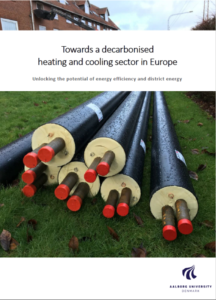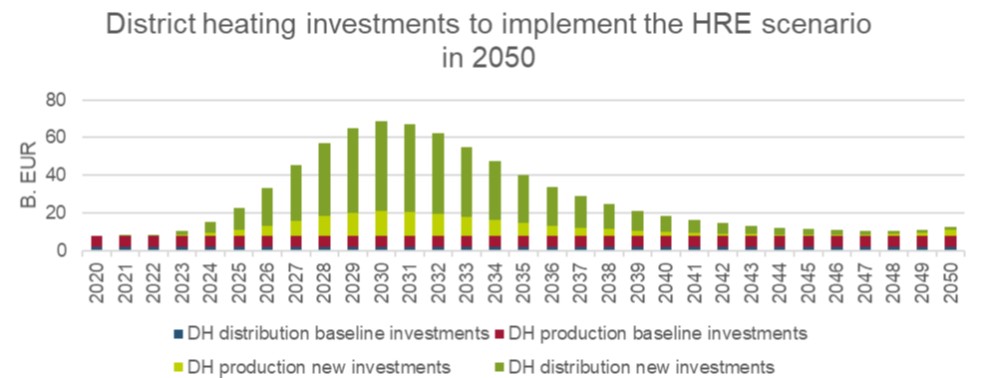New Roadmap for decarbonising Heating & Cooling sector
- News
- by Aalborg University
The latest scenarios from the European Commission include two scenarios in line with the 1.5 degree Paris Agreement targets. These two Net Zero Emission scenarios do not exploit the full potential of known technologies for energy efficiency (EE) and smart energy systems. District heating and cooling can improve EE and integrate more renewable energy, resulting in a lower cost fully decarbonised heating and cooling sector in Europe. We have created a detailed roadmap with policy measures and investments needed for exploiting the full potentials of EE.
“Net zero emissions in Europe is certainly achievable technically and economically. It does however require political changes in regulation. Our research shows that we need more than 21.500 new district heating systems in Europe and a massive billion-euro investment in better buildings until 2050. I hope the new Commission with Ursula von der Leyen in charge will make Smart Energy Systems coupling electricity, heat and gas grids a core part of Europe’s Green New Deal and an input from Europe to COP25 in Madrid,” says Brian Vad Mathiesen, Professor in Energy Planning and Renewable Energy Systems, Aalborg University.

In a new report titled “Towards a decarbonised heating and cooling sector in Europe – Unlocking the potential of energy efficiency and district energy” an energy system perspective quantifies the benefits of EE. A holistic supply chain perspective reveals equally large and feasible savings on both the end-demand side and on the energy supply side, resulting in lower CO2 emissions, lower costs and lower resource consumption.
The term ‘energy efficiency’ is often associated with a reduction of the consumer’s demand. Heat savings reduce demand so there is no longer need to supply as much heat and thus they should be highly prioritised. The concept of EE using district energy is more difficult to understand but is equally important. District energy enables the use of sustainable energy that otherwise could not be utilised e.g. geothermal, industrial waste heat, solar thermal. District energy is essential for low-cost energy storage and creates an important link to the electricity sector via large-scale heat pumps. A more interconnected energy system enables sector integration. In the same way, cooling demands often offer a direct opportunity to use the extracted heat in other applications e.g. district heating thus representing yet another synergy opportunity.
Based on the Heat Roadmap Europe project series (www.heatroadmap.eu), this report elaborates an investment roadmap and policy recommendations to implement the Heat Roadmap Europe scenario in 2050. To reach a fully decarbonised energy system in 2050, it is essential to establish many new district heating systems now, with a significant expansion of these from 2025. This report stresses the urgency of immediate action, and that the re-design of energy systems requires long-term strategic energy planning. It is necessary to maintain long-term goals and translate them into actionable steps such as investment levels, new capacity targets, EE targets and others.
As district energy solutions are cost-effective in the long run, but capital intensive upfront, reliable data and detailed knowledge for long-term planning are critical considering developments in heat demands, the building stock and availability of heat sources. The methods and research for such efforts are available and in that perspective, both the Energy Efficiency Directive and the Renewable Energy Directive should promote and encourage a comprehensive data collection infrastructure and methodology to help Member States and local authorities to plan and carry out a heating transition.
For more information, contact Brian Vad Mathiesen at +45 9940 7218 – [email protected] – @brianvad
Key findings, milestones and policy recommendations for an energy efficient European heating and cooling sector
• For a future low-carbon EU energy system it is essential that EE measures on the supply side, like district heating, are considered with equal importance for decarbonisation as measures on the demand side, like heat savings. They are fundamental to the technical and economic viability of the Smart Energy System (www.energyplan.eu/smartenergysystems).
• The total heat demand in Europe should be reduced by 30%. However, after this point the price of sustainable heat supply is likely to be lower than the price of further heat savings.
• District heating should be increased from today’s level of 12% up to approximately 50% in 2050 – ranging from 20-70% depending on the country. It should increase in urban areas, where the heat densities have been estimated based on the pan-European thermal atlas (www.heatroadmap.eu/peta4). 21,500 new district heating systems should be implemented by 2050 to reach this target, with a significant expansion between 2025 and 2035.
• New investments in new district heating production units and in new district heating distribution infrastructure should peak at 13.2 B. EUR and 47.6 B. EUR in 2030 respectively, moving from annualized district heating investment costs accounting for 18% today to 42% of the heat sector investment costs.
• These new district heating systems will be integrated with other parts of the energy systems and will use heat from power plants, industry, waste incineration, solar thermal, large-scale heat pumps, and deep geothermal.
• To ensure efficient district energy networks, it is important to move from existing supply to demand-side driven systems through state-of-the art control systems, paired with metering and consumption-based billing.
• Establishing the tools and having firm processes in place to properly assess the potential for district heating and cooling at the national level and make a detailed plan for how to reach this potential is essential. These assessments and plans should set commitments to deploy actions in liaise with the local level.
• Concrete proposals in the roadmap for the periods 2020-2030, 2030-2040 and 2040-2050.

Read more at heatroadmap.eu and access the report here
Latest News
-

-
 26.10.2021 Celsius Summit 2021 – Energy Democracy
26.10.2021 Celsius Summit 2021 – Energy Democracy

